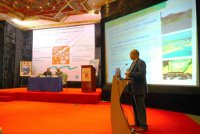 Held in Agadir, Morocco from 6 to 8 February 2012, the International Symposium on Mediterranean Water and Wetlands was attended by more than two hundred and fifty participants: a positive sign of raised awareness concerning the importance of these fragile ecosystems.
Held in Agadir, Morocco from 6 to 8 February 2012, the International Symposium on Mediterranean Water and Wetlands was attended by more than two hundred and fifty participants: a positive sign of raised awareness concerning the importance of these fragile ecosystems.
The International Symposium on Mediterranean Water and Wetlands, under the patronage of his Majesty King Mohammed VI, brought together a large number of stakeholders from all around the Mediterranean. The opening session was presided by Her Royal Highness Princess Lalla Hasna, President of the Mohammed VI Foundation for the Protection of the Environment. The Princess underlined that “the great challenge consists in ensuring coherence between strategic decisions for the conservation and resource development of these habitats and everyday needs or short-term interests.”
The aim of the Symposium was to present a status report on Mediterranean water and wetlands 20 years after the launching of the MedWet initiative, to assess new or emerging issues and to outline prospects for action in the next twenty years.
Several workshops were organised and the Symposium’s recommendations grouped in four areas:
1) faced with the continued degradation of wetlands, we need to double our efforts;
2) new partnerships must be established, particularly with development stakeholders, in order to raise awareness on wetlands and the services they provide, and to share our expertise more effectively;
3) civil society needs to play a more active role through networking and capacity building operations for regional, national, and pan-Mediterranean organisations;
4) the future of wetlands is in the hands of the younger generations, who should be more actively involved in our projects and events.
During the Symposium, the first report of the Mediterranean Wetlands Observatory, an operation initiated and led by the Tour du Valat, was officially launched. It gives the results of three years’ analysis of the status and evolution of wetlands in the Mediterranean basin, and of the pressures to which they are subjected. The report also highlights the services provided by wetlands and seeks to propose prospects for concrete conservation and sustainable management solutions. Two volumes have been produced. The General Report, targeting a scientific and technical readership, gives detailed descriptions of the seventeen indicators used, and analyses the results obtained. The Synopsis places its analysis in a broader context, and is aimed at decision-makers. Both are published in French and English.